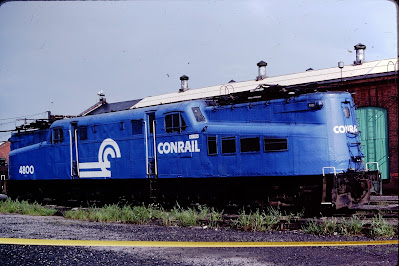Considering this is "April Fool's Day" I thought I would post about something completely random (but no fooling... I really do like these engines!)
I am too young to have seen a GG1 operate in real life. I was born in 1982, and most of them had been retired before then. In fact, only a few soldiered on until October 29, 1983, when the last ones were operated in revenue service. I have seen them in museums, State Fairs, and I even ran into a pair of them rotting away in Cooperstown, NY years ago unexpectedly while driving home from a work conference.
However, I am in the minority because I think the Pennsylvania Railroad's maroon and Brunswick green paint schemes were pretty boring. Instead, there are three schemes that I think are really sharp.
The first is Amtrak's "bloody nose" or "circus" scheme. Amtrak painted only about a half-dozen or so in red, silver, and blue, and one of them can be seen in the shot below dated March 1980. Note the boring black engine directly behind it.
Those who want to see an Amtrak bloody-nose GG1 can visit the New York State Fairgrounds in Syracuse, NY. Also, the Summer 2015 issue of Classic Trains magazine had an excellent article on an alternate Amtrak scheme with red and blue stripes that ran the length of the GG1's body. Frankly, I am glad Amtrak went with what they did.
The other two schemes belonged to Conrail. Their GG1s were inherited from Penn Central and mostly consisted of patched out black or Brunswick green bodies with "CR" stenciled on the side. But, Conrail did try two alternate schemes. The first was a bicentennial paint job from 1976 on #4800, "Old Rivets", named because it was the first GG1 off of the assembly line and the body it was riveted together instead of welding like the later engines. The shot below is from September 12, 1976. Wow, what an explosion of color! I love it, but it isn't for everyone. (Maybe I should have saved it for one of my July 4 posts.)
I saw two models of this engine recently. An HO scale brass model sold at a train show in December for $150. I passed, but a friend bought it. At another show, a Kato N scale model sold for $75. I showed it to my wife, but she said it was too gaudy and didn't want me to buy it. So I didn't. But I won't give up on it yet. I think I want one in O gauge for my next layout (for fun). Since most manufacturers use a GG1 mold without rivets (which is prototypical for most GG1s), all of the commercial models of bicentennial #4800 are missing the distinctive rivets. I guess the colorful scheme is so loud most people don't miss the little bumps.
Here is what #4800 looked like a couple of months later in November 1976, along with a couple other GG1s. It stands out in a sea of dark gray, black, and rust.
By 1978, the bicentennial celebrations were over and Conrail was ready to move on. So, it repainted #4800 in solid blue with a "can opener" logo. Shown here in September of 1979, it still cuts a striking image. As a Conrail fan from an early age, I love this scheme too.
A couple of years later found #4800 in May of 1981 with faded paint but still in decent shape.
When most people think of the GG1 they picture a fast-running Pennsylvania passenger train on the northeast corridor. Or, maybe they remember a Lionel model they had as a kid. Few would even cast a sidewise glance at these engines. But I think they are awesome!
For more information on GG1 paint schemes, an excellent online resource can be found here.






No comments:
Post a Comment